
|   |

|   |
World Dance Day celebrations - Dr. Sunil Kothari e-mail: sunilkothari1933@gmail.com May 7, 2012 Come April 29th and the Capital is agog with World Dance Day celebrations. Since past five years, I have been visiting Bangalore, attending Word Dance Day celebrations there. It was interesting for me this year to attend dance performances, seminars and other events organized mainly by two prominent institutions, viz., Natya Vriksha of Bharatanatyam exponent Geeta Chandran and Sadhya dance company run by Mayurbhanj Chhau and contemporary dance exponent Santosh Nair. Natya Vriksha had a two day dance celebration. On the 28th April at India International Centre's main auditorium, they had screening of a documentary film on Alarmel Valli (see separate review), followed by after screening talk, tea and performances by New Delhi's Kathakali dancer Kalamandalam Amaljith and Odissi by Ayona Bhaduri from Kolkata. At the same time in the evening, renowned photographer Avinash Pasricha's audio visual on Purvanga Gayaki events at Benares and Kolkata organized by Vikram Kapoor, was held at World Wide next door. Therefore, I missed Amaljith's Kathakali performance. But I could catch up with Ayona Bhaduri's Odissi recital. 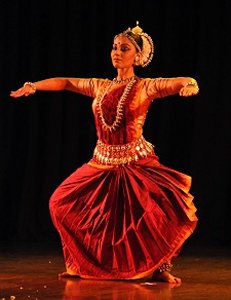 Ayona Bhaduri 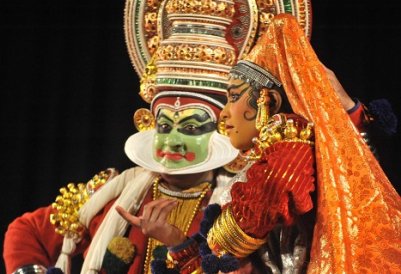 Kalamandalam Amaljith 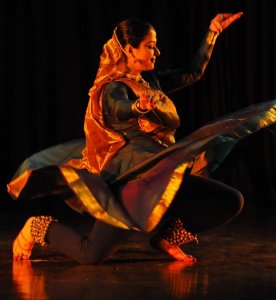 Monisa Nayak 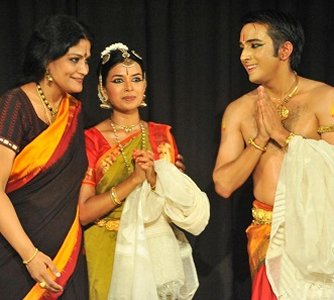 Geeta Chandran, Satyapriya Iyer, Christopher Gurusamy Ayona is trained at Kolkata by Sharmila Biswas, who has earned a reputation for pushing the boundaries of Odissi. She also encourages her disciples to explore the Odissi form. The three numbers Ayona presented were captivating. She seems to be completely immersed in dancing and is bound to go places. She has a stage worthy presence and performs with abandon. The striking feature is the element of sensuousness. It reminds one of Nrityagram dancers Surupa and Bijayani. If Ayona has imbibed that style, it suits her. The aesthetic appeal is highlighted in her costumes and large movements, covering of space, the movements of chest, and utplavanas, jumps. Odissi blooms with sensuous element. It is sculpturesque. There are those lovely curves and body bends, tribhanga and basic stance of chauka. The innumerable sculpturesque poses are interwoven in the choreography. With three musicians, vocalist, mardala player and flautist, Ayona wove a web of magic. From the opening number of Shiva Shakti sabdaswarapata, followed by Swara Vilas in Charukeshi (music by Debashish Sarkar) and Katha Surpanakha choreographed by Sharmila, Ayona succeeded in retaining attention of the audience. The sabdaswarapata, special compositions describing the iconic beauty of the God and the Goddess, was executed with aplomb by Ayona. Those kavit like compositions are a special variety of Odissi, which Guru Deba Prasad Das had specialized in. Ayona has a figure that falls into poses easily and the images created were captivating. Swara Vilas partook after swara delineation, elements of pallavi. The slow movements for solfas flowered. Though it was conceptualized as a longing for the lover, in spite of its abstract nature, the number was entertaining and replete with movements fitting the concept. It was in Katha Surpanakha that Ayona seemed to be in her element. The royal princess, moving in a forest and bathing in Godavari, sees the human footprints on the sand and is intrigued and follows it where Rama, Lakshmana and Sita are. She is attracted to the physical beauty of Rama, changes her form from demoness to a seductress. However, it does not work. She receives punishment from Lakshmana and her nose is chopped off. She is in great agony. Watching her reflection in water, she turns again into a demoness and helplessly throws her arms up in the air; that image was dramatic and effective. The narrative in Odiya like telling a story was interesting. The team of musicians did an excellent job. The three stages of Surpanakha were enacted by Ayona competently. As in nirtta so in abhinaya, Ayona displayed her potential. Here is a dancer from young generation to watch. Seminar on Corporate cultural responsibility 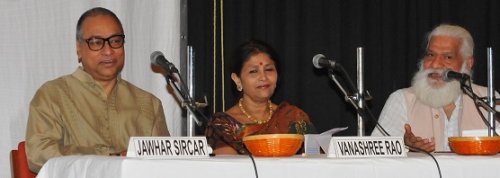 Jawhar Sircar, Vanashree Rao and Suresh Jindal
It was conducted in an ideal manner pinpointing various issues for different perspectives. Film maker / producer Suresh Jindal spoke of former times and how patronage was given by the kings and wealthy patrons. Vanashree Rao laid stress on sustainability and how young generation of dancers would benefit from collective work and meaningful approach to the funding agencies. Sanjeev Bhargav screened excerpts of choreographic works of Ananya Dance Festival at Purana Quila and spoke in detail of how he did not succeed in getting corporate support all these years and only NCT government supported the festival for ten years, which now has been given to other agencies to run it. Everyone was interested in how corporate sector would explain their position. Mr. Adhikari made an excellent power point presentation giving figures, graphs and explanations about the use of funds reserved for Cultural Responsibility. It was clear that a large amount goes to sectors like Education, Health, Medical care and the lowest rung is that of culture. There are tax benefits given for donations. But the corporate sector is interested in what they get out of supporting culture. What is in it for them? What mileage do they get out of promoting classical dance and music performances? The jargon like foot falls, feedback, percentage contribution, what is to be supported, sales, consumers, company process etc., were used and explained. For the past more than ten years, HCL gives finance to Habitat Centre for presentation of dancers to promote classical dance. Over the years, there have been ups and downs but it continues. Questions were asked why by writing a cheque, the cultural responsibility is not fulfilled. Leela Venkataraman and I responded by saying that we do not see the face of HCL at the dance performances. Of late, the artistes are not properly introduced, nor flowers given at the end. HCL's representative should be attending the performances, some sort of audit should be done and some improvements have to be made to make the entire exercise meaningful of providing financial assistance. 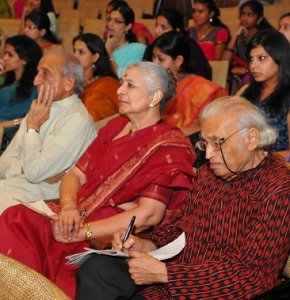 Om Prakash Jain, Leela Venkatraman and Dr. Sunil Kothari 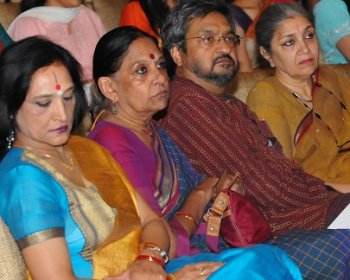 Ranjana Gauhar, Jaya Jaitley, Rajiv Bhargav, Mrs. Bhargav We heard the point of view of corporate sector. Sometimes it looked convincing, at times not. Shiva Nadar Foundation no doubt is doing praiseworthy work. Also one was happy to learn that HCL will be extending support to cultural organizations in Bangalore and Chennai. There is already established, the case of paintings at Kiran Nadar Museum of Art. The power point presentation helped a lot to understand the 'process' and what are the priorities corporate sector sets aside. Mr. Adhikari agreed that he would look into the matter of HCL representative attending the events and in turn getting sensitized to performing arts and also gave some idea of how successful the aim of cultural responsibility is achieved. Sanjeev Bhargav explained how there is some tangible benefit available to corporate sector when they organize Art camps, where painters undertake to do paintings for a week and in return leave one painting with the corporate sector. The market for paintings as is known is very high and at the end of the camp the corporate sector gets something back in return. In case of supporting classical dance performances, the corporate sector does not get anything in return, as dance is an ephemeral art and vanishes once the performance is over. However, it would be wrong to think that classical dance performances do not sensitize people. Besides entertainment value, the dance performances help audiences to respect and appreciate the cultural heritage we possess and it is important therefore that dance performances should be supported. Sanjeev Bhargav has vast experience of presenting dances not only within India but also abroad as agencies like Indian Council for Cultural relations (ICCR) often request him to arrange events. He has succeeded in bringing large masses to Ananya Festival at Purana Quila and through Bhakti Sangeet at Nehru Park. The large turnout of audiences is the proof. He confessed that somehow, the corporate sector does not support it. Jawhar Sircar gave us statistics which were eye opening. The government spends only 11 paise out of 10,000 paise set aside for culture. He gave examples of Guggenheim and Rockefeller Foundations where the wealthy patrons believed in supporting the arts and made funds available wisely. In Islam, it is compulsory to give 5% Jakat for social work; similarly Christians and Jews also set aside some portion of wealth to be given for charity. In India, there is concept of Daan - donations - people give for religious causes, building temples. Government intervention is very important. The schemes for tax benefits, the need for rewarding marketing strategies, how to create hype for art etc. are issues which artistes should take into account. Om Prakash Jain of Sanskriti Foundation, who had a decade ago organized a similar seminar and had worked out a paper for policy, suggested that the discussion should be brought out in form of a booklet and what further action should be taken. He also drew attention to too many performances. He gave example of Kumar Gandharva who would give only two performances within a year in Delhi and keep audiences hungry for his art. He also felt that performance by solo dancers before large audiences defeats the purpose as solo dance must have a baithak type chamber like presentation. Kuchipudi exponent Rashmi Vaidyalingam drew attention to dance being not made a compulsory subject in school. She argued that if it is made a compulsory subject, there would be demand for dance, teachers will be in demand and that would solve part of the problem. I feel it is important to have dance as a compulsory subject so that teachers and young generation would get sensitized about our dance. At present, the common law in economics prevails: where there is less demand and more supply, the prices fall. That is what the present situation is. Too many dancers, well qualified, but there is no great demand for dance performances. And whatever one may say, classical dances remain an elitist art form. Along with SPICMACAY's excellent work for initiating young generation into classical dance and music through lec-dems by leading artists, the turnout of audiences is limited. However, the work of SPICMACAY must be supplemented by continuous lec-dems in order to evoke appreciation of classical dances for common people who would then flock to watch performances. Her daughter Shloka suggested exploring through electronic media and internet, how to reach out to potential audiences, giving example of what National Centre for the Performing Arts does in Mumbai. She also referred to arts as creative industries. Several suggestions were given. As Geeta Chandran had mentioned in her article on Corporate Cultural Responsibility, the artiste community has to know the issue of information and transparency. What partnerships are offered and what the costs will be. The hard-as-nail decision makers in corporations seek hidden advantages. She has rightly emphasized the need for creating modules by which corporate decision makers can engage in enlightened decisions on the arts. Synergy between the two can probably augur a better future for the creative arts in India, even while reassuring the corporations of clearly assessable benefits in the long term. Rajiv Chandran moderated the discussions admirably. The seminar was indeed thought provoking. On a Sunday afternoon lots of people whose voices matter in arts attended the seminar that speaks volumes of Geeta and Rajiv's efforts. Heartiest congratulations to them and we look forward to having the publication of the report and another seminar next year on 'Arts as creative industry.' No Boundaries - a carnival of dance by Sadhya and National School of Drama (NSD) The World Dance Day Celebrations in collaboration with NSD and with support from ICCR continued on Sunday evening at Abhimanch, NSD's theatre where under Santosh Nair's artistic direction, 65 dancers of various groups ranging from classical to contemporary dance forms participated. The show began with artistes trained by Santosh Nair presenting outside Abhimanch at the entrance, performance with prayers to Lord Shiva in various yogic poses and difficult-to- maintain headstands and acrobatic positions. They set the tone for what was to follow in the auditorium. The opening with all artistes coming in groups on stage offering prayer filled the stage with colours and a variety of movements. Astad Deboo's dancers from Salaam Baalak Trust displayed through slow movements, a feeling of space and balance. Then the groups started coming one by one in a seamless manner, with perfect sync, to different music and exquisite lighting. It would be invidious to single out any group but undoubtedly Sadhya's star performer Tushar Kalia with his leaps and aerial movements along with the dancers won rounds of applause. Ditto for Goura Prema of Natya Nectar's group, who with aerial skills, yoga, acrobatics, balance, mesmerized the audience. The artistes were well trained and performed with great energy. Shashank Dogra, Hari Narayan and group with their fantastic somersaults had audiences applauding the moment Hari Narayan, an artiste from Africa, who has been working with the group, performed various feats. His physical strength and control over body revealed movements which added to one's delight. Atul Jindal, Karan Kumar of Big Dance Centre had elements of jazz, ballet, contemporary mix which went down well with the Carnival spirit. Kauleshwar Kumar Thakur, Ajay Kumar Bhatt, all part of Sadhya at one time or another, danced with abandon. And of course Dadi Pudumjee's live puppets brought in not only variety but energetic performance by a female dancer and the male dancer who danced along with the live puppets. The manipulation was done with imaginative approach. The puppets, as it were spoke.
Photos: Paradise Clikography Among all these contemporary dancers, the group of Bharati Shivaji gave a graceful Mohiniattam performance with poet Vallathol's Pandattam, a ball game composition to raga Kamboji set to adi tala. They looked gorgeous in typical Mohiniattam costume. Madhavi Mudgal's group performed Odissi to music by Madhup Mudgal, a perfectly synchronized pure dance choreography, creating exquisite visuals with appropriate lighting. Shovana Narayan's group danced Kathak with zest, the male and female dancers taking chakkars and covering the stage, to the prayer to Lord Shiva and Ravanastotra. The group of Saroja Vaidyanathan performed Kavutvam and both the groups jelled well interacting, creating synergy that charged the theatre. The finale with all coming together was a stunning sight- no glitches, no clash, no confusion. All together further enhanced the feeling of a joyous carnival. Amal Allana, Chairperson of NSD, complimented all and suggested that the show must travel to other cities and assured full support to dancers to join hands with NSD. Bravo, Santosh Nair. One moved out of the auditorium with a spring in one's walk. Indeed a joyous World Dance Day celebration.  Dr. Sunil Kothari is a dance historian, scholar, author and a renowned dance critic. He is Vice President of World Dance Alliance Asia Pacific India chapter, based in New Delhi. He is honored by the President of India with Padma Shri, Sangeet Natak Akademi award and Senior Critic Award from Dance Critics Association, NYC. He is a regular contributor to www.narthaki.com, the roving critic for monthly magazine Sruti and is a contributing editor of Nartanam for the past 11 years. Post your comments Pl provide your name and email id along with your comment. All appropriate comments posted with name and email id in the blog will also be featured in the site. |